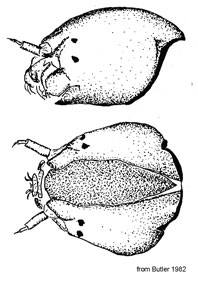Species 3s. C. tardus Butler 1982.Adult: Weak or absent scutal tubercle. Abdominal segments dark, but often pale on posterior margins. Fore leg with moderate beard, BR 4-7. LR1 1.01-1.14 ; LR2 0.56-0.64; LR3 0.67-0.73. Sensilla chaetica: Leg2 21-46; Leg3 15-34 Segment TIX with 8-31 setae. Anal point relatively narrow; superior appendage of the D-type of Strenzke (1959); inferior volsella parallel over entire length (unlike C. prior where they turn outward over the distal third) and slightly longer than the anal point and about to the midpoint of the gonostyle, which is relatively narrow and narrows only slightly over the posterior third.  Identification: The lower LR1 and the higher number of sensilla chaetica are useful for separating this species from C. prior. with scutal stripes, postnotum, etc., dark brown. Abdomen similar color to males. Fourth instar larva a salinarius type. Very dark gular region, dark frontoclypeus, but rest of head paler. Ventral head length 351 (320-386) µm; head width 662 (629-717) µm. Head capsule larger and paler than that of C. prior.  Cytology: 4 polytene chromosomes with the thummi arm combination: AB, CD, EF, G. Found: Alaska - Pond S, Barrow; Loon Pond, Prudhoe Bay (Type locality). Description of larva by Butler (1982) and cytology given by Wülker & Butler (1983). |
Modified: 13 May 2021
Access: Unrestricted
Copyright © 2000-2021, Jon Martin.